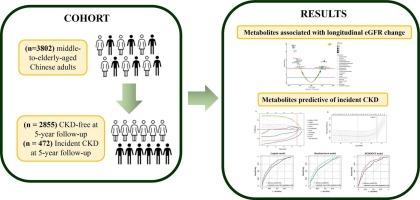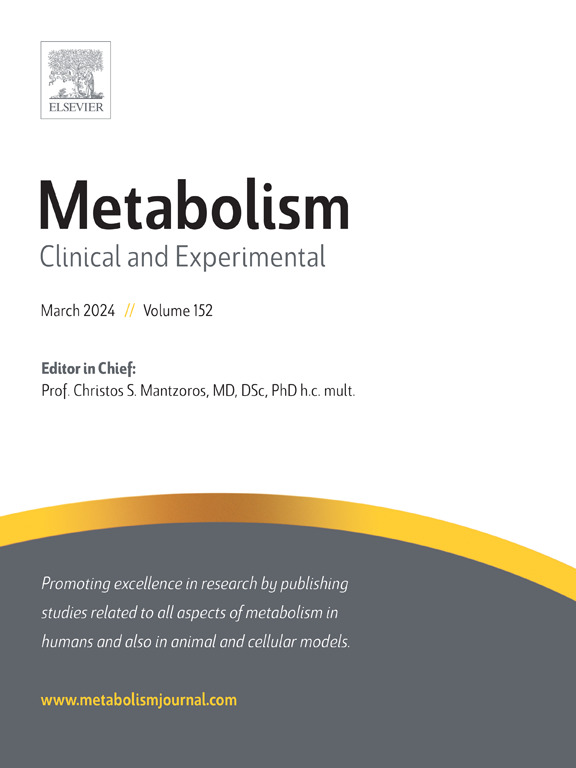靶向代谢组学鉴定出新的代谢物,主要是磷脂酰胆碱和含二十二碳六烯酸的脂质,可预测中国中老年成人慢性肾病的发生。
IF 11.9
1区 医学
Q1 ENDOCRINOLOGY & METABOLISM
引用次数: 0
摘要
背景:关于循环代谢物与肾功能下降的关系的证据有限,更不用说它们在预测慢性肾脏疾病(CKD)发展中的价值了。方法:本研究纳入了3802名年龄为64.1 ± 7.4 岁的参与者,其中3327名基线时无ckd(估计肾小球滤过率[eGFR] > 60 ml/min / 1.73 m2)。我们用液相色谱联用质谱法测量了211种代谢物的基线水平,包括25种氨基酸、12种酰基肉碱、161种脂质和13种其他代谢物。结果:eGFR的平均(SD)绝对年变化为-0.14 ± 4.11 ml/min / 1.73 m2 /年,在4.6 ± 0.2 年(14.2 %)的随访期间,共有472名基线时无CKD的参与者发生了CKD事件。我们共鉴定出22种与年度eGFR变化相关的代谢物,并通过多次Bonferroni校正存活下来,包括7种与eGFR增加相关的代谢物(6种是含二十二碳六烯酸[DHA]的脂质)和15种与eGFR下降相关的代谢物(9种是磷脂酰胆碱[PCs])。其中,8种代谢物在最小绝对收缩和选择算子(LASSO)回归中获得非零系数,具有预测CKD的潜力,包括1种氨基酸(精氨酸)、1种酰基肉碱(C2)、1种溶血磷脂酰胆碱(LPC 22:6)、2种pc(32:1和34:3)、1种三酰基甘油(TAG 56:8[22:6])和2种其他代谢物(肌苷、烟酰胺)。8种代谢物的综合评分比值比(OR)为8.79(95 %置信区间[CI]: 7.49, 10.32;在1000次重复的10倍交叉验证中,P -11)至0.765(0.742至0.788),而两种先进的机器学习算法,随机森林(RF)和极端梯度增强(XGBoost)模型的应用产生了相似的c统计量,分别为0.753(0.729至0.777)和0.778(0.733至0.824),增加了0.074(0.055至0.093;P = 4.11 × 10-14)和0.073 (0.032 ~ 0.114;4 P = 4.00 × 打败),分别。结论:在这项研究中,我们确定了22种与eGFR纵向变化相关的代谢物,其中9种是pc, 6种是含dha的脂质。我们筛选出一组8种代谢物,这些代谢物比包括基线eGFR在内的传统危险因素提高了9 %的CKD发展预测。我们的研究结果强调了脂质代谢与肾功能损害的关系,并为CKD风险提供了新的预测指标。本文章由计算机程序翻译,如有差异,请以英文原文为准。

Targeted metabolomics identified novel metabolites, predominantly phosphatidylcholines and docosahexaenoic acid-containing lipids, predictive of incident chronic kidney disease in middle-to-elderly-aged Chinese adults
Background
Evidence is limited regarding the association of circulating metabolites with decline of kidney function, letting alone their value in prediction of development of chronic kidney disease (CKD).
Methods
This study included 3802 participants aged 64.1 ± 7.4 years from the Dongfeng-Tongji cohort, among whom 3327 were CKD-free at baseline (estimated glomerular filtration rate [eGFR] > 60 ml/min per 1.73 m2). We measured baseline levels of 211 metabolites with liquid chromatography coupled with mass spectrometry, including 25 amino acids, 12 acyl-carnitines, 161 lipids, and 13 other metabolites.
Results
The mean (SD) absolute annual change in eGFR was −0.14 ± 4.11 ml/min per 1.73 m2 per year, and a total of 472 participants who were free of CKD at baseline developed incident CKD during follow-up of 4.6 ± 0.2 years (14.2 %). We identified a total of 22 metabolites associated with annual eGFR change and survived Bonferroni correction for multiple testing, including seven metabolites associated with eGFR increase (six being docosahexaenoic acid [DHA]-containing lipids) and 15 associated with eGFR decline (nine being phosphatidylcholines [PCs]). Among them, eight metabolites obtained non-zero coefficients in least absolute shrinkage and selection operator (LASSO) regression on incident CKD, indicating predictive potential, including one amino acid (arginine), one acyl-carnitine (C2), one lysophosphatidylcholine (LPC 22:6), two PCs (32:1 and 34:3), one triacylglycerol (TAG 56:8 [22:6]) and two other metabolites (inosine, niacinamide), and the composite score of these eight metabolites showed an odds ratio (OR) of 8.79 (95 % confidence interval [CI]: 7.49, 10.32; P < 0.001) per SD increase in association with incident CKD. The addition of the metabolite score increased the c-statistic of the reference model of traditional risk factors (including baseline eGFR) by 0.065 (95 % CI: 0.046 to 0.084; P = 3.39 × 10−11) to 0.765 (0.742 to 0.788) in 1000 repetitions of 10-fold cross-validation, while the application of two advanced machine learning algorithms, random forest (RF), and extreme gradient boosting (XGBoost) models produced similar c-statistics, to 0.753 (0.729 to 0.777) and 0.778 (0.733 to 0.824) with increases of 0.074 (0.055 to 0.093; P = 4.11 × 10−14) and 0.073 (0.032 to 0.114; P = 4.00 × 10−4), respectively.
Conclusions
In this study, we identified 22 metabolites associated with longitudinal eGFR change, nine of which were PCs and six were DHA-containing lipids. We screened out a panel of eight metabolites which improved prediction for the development of CKD by 9 % beyond traditional risk factors including baseline eGFR. Our findings highlighted involvement of lipid metabolism in kidney function impairment, and provided novel predictors for CKD risk.
求助全文
通过发布文献求助,成功后即可免费获取论文全文。
去求助
来源期刊

Metabolism: clinical and experimental
医学-内分泌学与代谢
CiteScore
18.90
自引率
3.10%
发文量
310
审稿时长
16 days
期刊介绍:
Metabolism upholds research excellence by disseminating high-quality original research, reviews, editorials, and commentaries covering all facets of human metabolism.
Consideration for publication in Metabolism extends to studies in humans, animal, and cellular models, with a particular emphasis on work demonstrating strong translational potential.
The journal addresses a range of topics, including:
- Energy Expenditure and Obesity
- Metabolic Syndrome, Prediabetes, and Diabetes
- Nutrition, Exercise, and the Environment
- Genetics and Genomics, Proteomics, and Metabolomics
- Carbohydrate, Lipid, and Protein Metabolism
- Endocrinology and Hypertension
- Mineral and Bone Metabolism
- Cardiovascular Diseases and Malignancies
- Inflammation in metabolism and immunometabolism
 求助内容:
求助内容: 应助结果提醒方式:
应助结果提醒方式:


